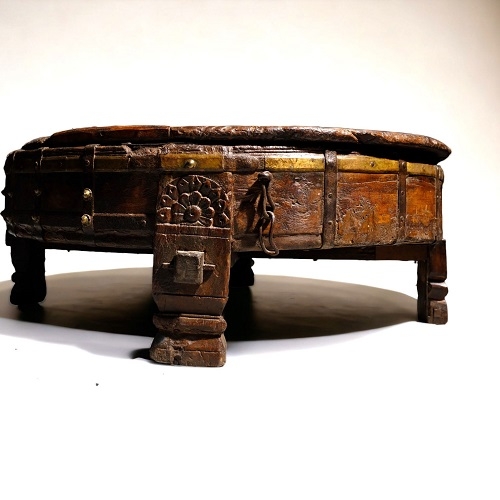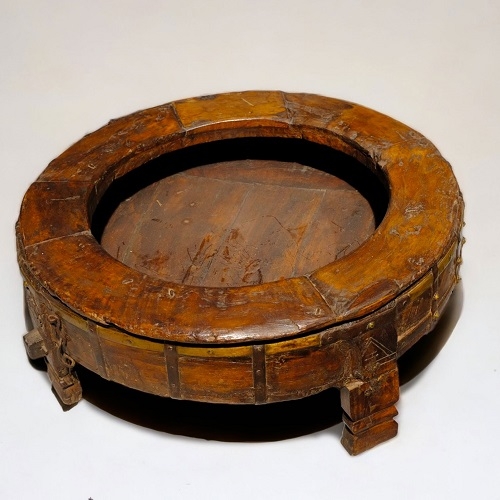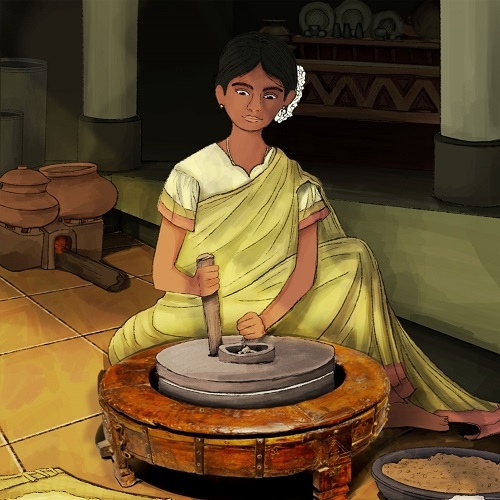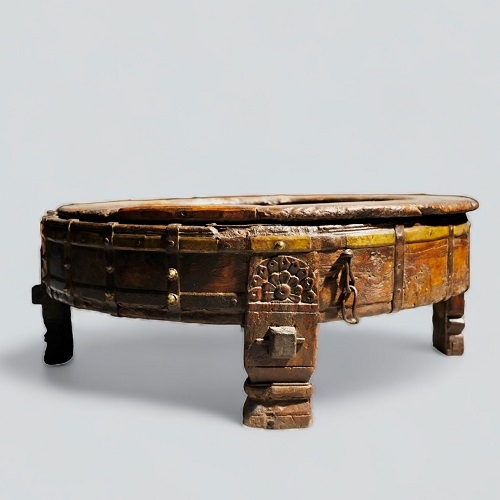You have no items in your quote list.
- Home
- Antique Hand Carved Teak Wood Chakki (Grinding) Table
Details




This antique Indian hand-carved Chakki grinder table is a beautiful and unique statement piece with a magnificent history that originated in India.
The origin of a chakki table lies in Rajasthan, India. It is a table with grindstones incorporated into its design. The main aim of the construction of a chakki table was to collect the wheat, pulses, spices, or any other food grain that was turned into their powdered forms by the movement of the chakki.
Traditionally used as home stone mills, the grains were sorted and ground into flour. These tables were a stable fixture in all homes in traditional Indian village life. Originally it would have been accompanied by 2 heavy grinding stones, one placed on top of the other. The top one has a basic handle to rotate around grinding the wheat into flour or Indian spices into powder. The construction of a chakki is in pairs. It consists of two stones, the bottom stone acts as a stationary base known as a bed-stone and the other is a rotating stone above the bed-stone known as a runner-stone. The movement of the runner-stone against the bed-stone creates a scissoring action that grinds the grains trapped in between the two stones.
The flour, spice, or any other food grain is ejected out from the edges of the rim of the stones which is then collected by the table underneath the chakki. The chakki is often referred to as the oldest industry as humans have been using the chakki for food processing since Upper Paleolithic times (50,000-12,000 years ago).
This Chakki is a hand-carved piece, it is a sturdy, round table made from a rich, dark teak. The Chakki/Coffee table has four strong short legs with a carved floral design, and metal straps and studs on the outside edge of the table. Teak wood is renowned for its durability and natural beauty. It has a smooth and polished surface, which feels cool and comforting. The wood has a deep, reddish-brown patina that exudes warmth and character.
The name chakki is derived from the Sanskrit word chakra which means wheel or circle. It consists of a hand-operated flat circular stone that is placed on another similar disc. These are manufactured by specific professionals of a community. The construction of a chakki is time-consuming and depends upon acquiring the raw materials and the number of people available for the work. Usually, gneiss stones are collected to create the two circular grinding stones for the chakki. These stones are either locally available or they have to be excavated from a nearby mountain or has to be broken from a rock. These stones are then processed with the use of tools like a hammer and chisel etc. for shaping, polishing, and finishing the grinding stones.
An off-center wooden handle (galua) is attached to the rotator stone which is hand-operated and is moved in a clockwise direction to grind the grains. The handle is generally made of locally available hardwood, but usually, oak or teak is preferred. The women of a household work in pairs to move the rotator stone. The diameter of the stone is less than a person's arm's length, and two people sit facing each other and move the chakki with its handle together to ease out the work. The bigger the stone the faster the process of grinding and the finer the product, but its operation by hand makes it a limiting factor.
The surface of the chakki stones has deep grooves called furrows and flat areas called lands. The groove acts as the grinding area as it provides a cutting-edge and helps in channeling the flour out of the chakki. The furrows and lands are created in a repeating pattern and created on both bed-stone and runner-stone on the sides facing each other. These patterns when rotated against each other create a mesh in which the grains are trapped and the scissoring motion grinds the grains. The patterns need to be re-cut after a period of regular use.
The chakki table was created by the local wood craftsman of the village known as Sutradhar or Suthar. Generally, the shape of the table is round in accordance to the shape of the chakki but tables of triangular and rectangular shapes were also created depending upon the wish of the user.
The chakki table was mostly found in the houses of economically affluent families. They symbolized the economic prosperity of the household and the designs on the table provided an aesthetic look to it. The chakki table became an inseparable object of a traditional household. From its humble beginnings to its rise as a symbol of prosperity to its downfall to obscurity, the chakki table is making a resurgence in modern households. It symbolizes a plentiful household tracing its origins to the Indian culinary heritage.
In modern times they found their place as decorative or functional furniture pieces. They can be used as coffee tables, side tables, or even display pieces, adding a touch of rustic charm to interior decor. This antique Indian teak wood Chaki table is a stunning piece of furniture that combines the beauty of teak wood with hand-carved designs which makes it a unique and remarkable addition to any room. The antique wooden Indian chakki table (grindstone table) is emerging as one of the most sought coffee tables or side tables depending on the varied size of its construction. The chakki table provides a perfect Bohemian vibe to any household.
Additional Information
| Size | No |
|---|---|
| Height | No |
Wow Rentals is a South East based specialised event furniture hire company , we have a wide range of furniture at great prices. We supply within London as well as the East, South East & Midlands.
Add the Wow Factor to your events, contact us to meet your contemporary event furniture needs. We cater for all types of events from corporates to smaller events
Wow Rentals
Our Favorites
Artificial Tree Hire
Like us for updates
Wow London T/A Wow Rentals, 10 Harland Ave, Croydon, CR0 5QB. All Prices are Ex-Vat. Company number: 09056521 Contact Us

